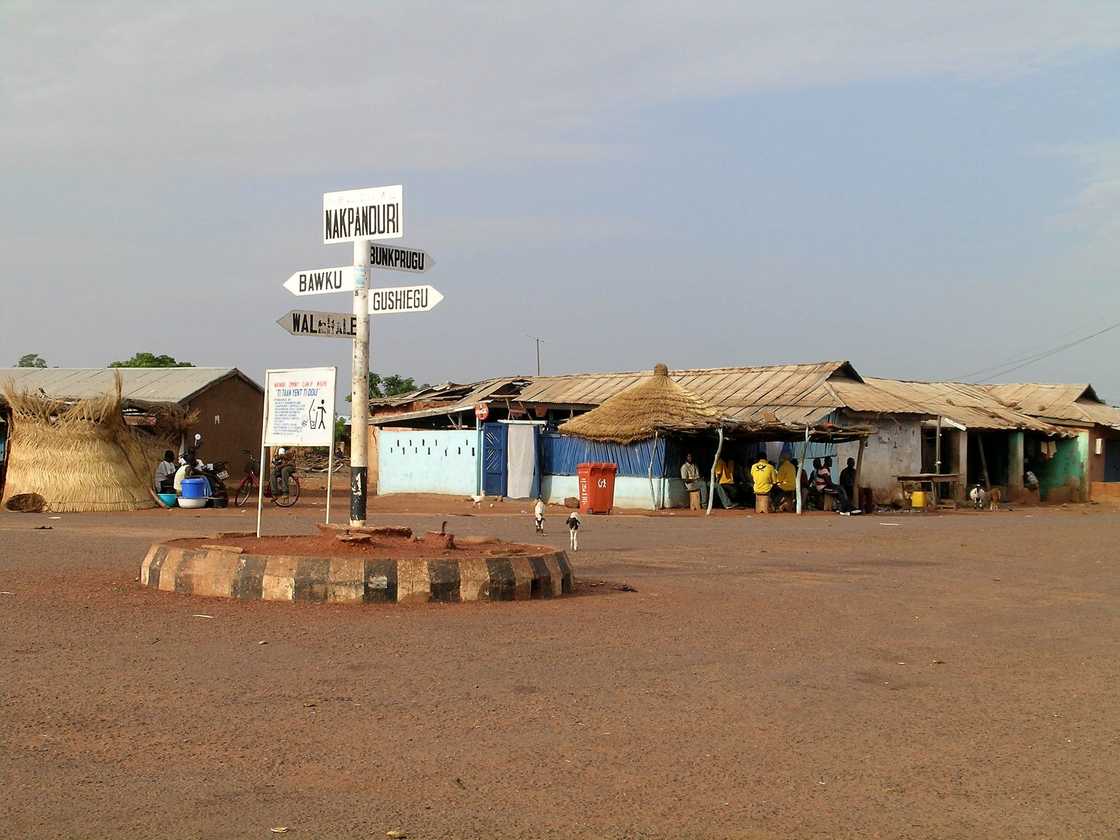What are some of the ancient towns in Ghana and their regions?
Compared to other countries in Africa, Ghana is home to many ancient towns that carry so much significance in the civilization and growth of the area. Most of these ancient towns in Ghana and their regions started as trading centres for products and enslaved people. They date back to when man saw the need to start agricultural production and trade the surplus for those commodities he did not have.

Source: Getty Images
Due to a lack of documentation, there is a danger that Ghana may forget about some of the places that were crucial in the country's history. This country is rich in unwritten and unseen history, which should be conserved at all costs. Among the historical attractions that people need to know about are the ancient towns in Ghana and their founders.
Ancient towns in Ghana and their regions
Accra is the city of Ghana, but it is relatively new compared to several other towns like the ancient towns in Ghana Begho. These towns were like big cities in the past. Below are some of the most ancient towns and their regions:

Read also
Endangered buildings like Mosque City of Bagerhat, La Maison du Peuple, and others that need immediate attention
1. Nzulezu Stilt – Jomoro District, Western Region

Source: UGC
It was a one-of-a-kind town built on a lake on the coast in the western part of the country. The village is about 400 years old and near the border with Cote d'Ivoire. It was built on stilts in Lake Tadane.
In the Nzema language, the name Nzulezu means the water's surface, hence the village's naming. The inhabitants of the village came from an ancient Ghana empire called Walata. The centre stands on one long pier with buildings constructed on both sides. One side has living quarters while the other has businesses and a school.
2. Nakpanduri – Bunkpurugu-Nakpanduri District, North-East Region

Source: UGC
This ancient town is found in the North East region of Ghana adjacent to the Togo border. Here is where the Tusugu cliff dwellings were discovered in 1961. Unfortunately, these ancient settlements receive few visitors because of their remote and inaccessible location.
People lived in granary-like structures, some over 4 meters high. Most of the structures were around a stream where inhabitants could fetch water. Rock paintings on the cliff walls depict different things, such as animals and people.
3. Assin Manso – Assin South District, Central Region

Source: Twitter
The ancient town sprung to life because it served as a slave market during the era of the slave trade. It was one of the largest slave markets where people were sold as enslaved people. The town is about 40 km along the Cape Coast – Kumasi highway.
Because the captured people were given the last ritual bath here, the town has been declared a sacred place of remembrance. The town hosts the Memorial Wall of Return, where Africans write their names to show that they have found their roots.
4. Kumasi – Ashanti Region

Source: UGC
The city of Kumasi is one of the ancient towns in the Ashanti Region, founded in 1680. It is found in a rainforest region near Lake Bosomtwe. It is the capital of the historical Ashanti Empire. It was distinctive due to its many species of flowers and plants; thus, it earned the name "The Garden City".
Today, Kumasi is the second-largest city in Ghana after Accra. The British destroyed parts of the city during the Third Anglo-Ashanti War of 1874. The natives claim that it is in this town where Okomfo Anokye received the golden stool.
5. Daboya – North Gonja District, Savannah Region

Source: UGC
Daboya is the current capital of the North Gonja district in the Savannah Region of Ghana. About a century ago, Daboya used to be the most popular town in the northern part of Ghana due to its mass production of salt.
Settlement in this town can be traced back to 1000 BC when it was a Kintampo culture site. Unfortunately, the settlement was destroyed in the 1890s by slave raiders. Today, the sites boast tourist attractions such as traditional burial mounds, comb-decorated pottery and an extant mosque.
6. Salaga – East Gonja District, Savannah Region

Source: UGC
The town is found in the southernmost reaches of the Sahel. Salaga was a crucial market town in the eighteenth and nineteenth centuries. It served as a commercial centre facilitating regional kola trade between the north and the south.
Salaga has always had a cosmopolitan population due to the influence of trade. Its inhabitants included the Hausas, Wangaras, Gurmas, Dagomabs and other groups. In addition, its market was a transit point through the northern Sahel and the southernmost coast, as well as other towns like Yendi and Kpabia.
7. Kintampo – Bono East Region

Source: UGC
The town of Kintampo is found in the Bono East Region of Ghana and is the capital of Kintampo North Municipal. The town is home to the Bono and the Mo tribes but has also attracted people from other tribes.
The town is associated with the Kintampo complex, the prehistoric period that saw the transition to sedentism in West Africa. Inhabitants stopped being forest dwellers and started developing systems of agriculture. Apart from pastoralism and horticulture, the people of Kintampo also created art and items of personal adornment.
8. Larabanga – West Gonja District, Northern Region

Source: UGC
The village known as Larabanga is found in the West Gonja District of the Northern Region of Ghana. One of the town's historical sites is the famous whitewashed adobe Sahelian mosque, built-in 1421. It is the oldest mosque in Ghana and has a copy of the Quran that is almost as old.
Other attractions in this village include the Mystic Stone, vernacular architecture and the entrance of the Mole National Park. During the British rule, a road was being constructed near the Larabanga road, but when they uprooted a stone along the way, they woke up the following day to find the stone where it was. The same incident repeated itself two times; hence they decided to construct a road around it.
9. Cape Coast – Central Region

Source: UGC
Cape Coast is the capital of Cape Coast Metropolitan District and the Central Region of Ghana. It is a historic city that was declared a World Heritage Site. The Cape Coast Castle is found in this city. It was a transit point for Portuguese navigators in the Ghana Empire during the 1400s.
Between the 16th century and Ghana's independence in 1957, the city changed hands between the British, Swedish, Portuguese, Dutch and Danish. The founders of this great city are the people of Oguaa.
10. Elmina – Central Region

Source: UGC
Sometimes known as Edina, Elmina is a town strategically situated on the south coast of Ghana on a bay of the Atlantic Ocean. It is about 12 km from Cape Coast. The town was the first settlement of the Europeans in West Africa.
Before the Portuguese arrived, Elmina used to be called Anomansah because it was located on the Peninsula between the Benya lagoon and the sea. The 1478 Battle of Guinea occurred near Elmina, ending with the Portuguese winning and ruling most West African territories.
Frequently asked questions
- What were the ancient towns in Ghana? Some of the most ancient towns in Ghana include Elmina, Cape Coast, Larabanga and Kintampo.
- How many ancient towns are in Ghana? There are many ancient towns in Ghana; some of them are Nzulezu Stilt, Nakpanduri, Elmina, Cape Coast, Larabanga, Kintampo, Salaga, and Daboya.
- Are there any ancient towns in the Ashanti region? Yes, there are many towns in the Ashanti region because civilization in Ghana started with the Ashanti Empire.
- What name did Queen Elizabeth II give Kumasi? She named the town the “Garden City of Africa”.
- What are ancient towns? These are towns over 2000 years old and usually have a historic background centred on culture or religion.
- What was the first town to develop in Ghana? Koumbi Saleh is said to be the earliest town in Ghana.
- Who is the founder of Kumasi? The town of Kumasi was established by Osei Tutu, the first king of the Ashanti empire.
Ghana is at the centre of the history of Africa because of its rich cultural heritage predating even the Ashanti civilization. Sadly, some of the darkest elements of the history of Africa find a home in this part of the continent. For example, most enslaved people destined for Europe and other parts of the world came from or passed through Ghana. This trade of human beings contributed to the growth of some of the above ancient towns in Ghana and their regions.
Yen.com.gh shared an interesting article about the major ethnic groups in Ghana. Ghana is the second-most populous country in West Africa after Nigeria. It is a multiethnic, multilingual, and multireligious country.
Ethnic groups in Ghana make up the majority of the country's inhabitants. These groups are numerous and have unique cultures and traditions. Furthermore, their coexistence has resulted in the development of new cultures and traditions.
Source: YEN.com.gh







